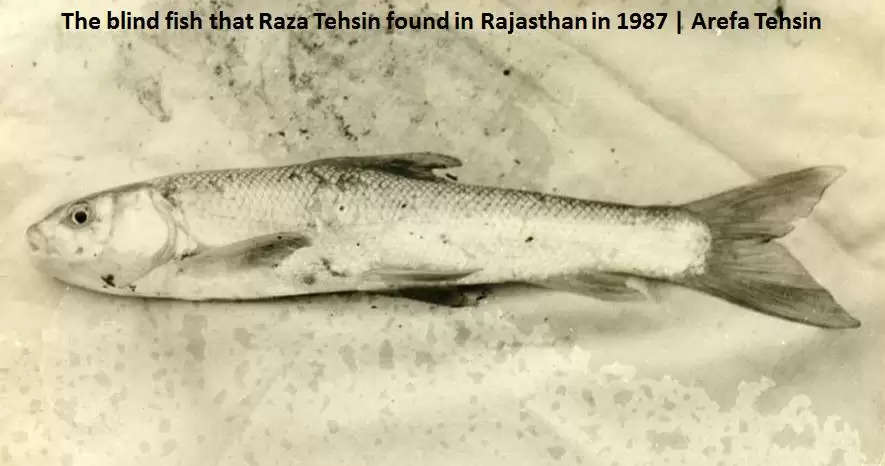Snow Trout in the Aravalis - do the water bodies in the Aravalis have a centuries old connection with Himalayan rivers?
Occurrence of a Schizothoracine Fish (Snow Trout) in a Subterranean Cave in the Aravalis near Udaipur in Rajasthan may well substantiate this claim...
It was Dr Raza Tehsin of Udaipur who chanced upon this discovery during a project at Matoon Mines near Udaipur in 1987...the story behind it...
Schizothoracine fish inhabit hilly streams and lakes in the Himalayan and sub-Himalayan region extending to China (Day 1958). Jayaram (1981) gives their distribution as Kashmir, Punjab, Afghanistan, Pakistan, Tibet and Nepal.
One individual of this subfamily (Schizothoracinae) was caught in a subterranean cave having its entrance about 50 ft below the surface in the hilly terrain of Aravali ranges near Udaipur (lat. 24°-34¢N; long. 74°- 40¢E). The cave, which had never been explored in the past, is said to have been formed by copper mining activities in ancient times (around 3-4 thousand years back). The cave is dark and appears fairly wide in its spread with interconnecting channels. These channels are unapproachable, being very dark and at places too low in height. At the time of capture of the fish in May 1987, the cave’s water had a temperature of 18°C.
The fish was seen swimming near the entrance of the cave. It was caught and identified as belonging to the subfamily Schizoracinae. The species could not be ascertained with the help of available literature as several characters of two genera Schizothorax Heckel and Diptyhcus Steindachner overlapped in the specimen.
The description of the fish is as follows:
Body elongated, sub cylindrical, abdomen rounded. Head large, rounded anteriorly, snout obtuse, smooth. Mouth inferior, crescentic, lower lip with papillated margin forming a reduced sucker (character of the genus Schizothorax). Eyes large, 6.7 in head length, laterally placed, barely visible from the ventral side. Total length 23.6 cm, standard length 18.8 cm; depth 3.9 in standard length and 4.81 in total length. Head 4 in standard length and 5.02 in total length. Only two barbells visible, maxillary in position, minute, less than the diameter of the eye. Dorsal fin inserted almost half ahead of the pelvic fin, beginning above the posterior tip of the pectoral fin. Dorsal fin 1+9, pectoral fin 17, pelvic fin 9 with a fleshy appendage in the axil (character of Diptychus), anal fin 7. The tile row of scales over the anal fin not much developed. Caudal forked 12+12, lateral line curved anteriorly ending in the middle of caudal fin. Lateral line scales 64 (unlike Schizothorax and Diptychus)
The occurrence of a Schizothoracine fish in the region south of Aravali hills in Rajasthan is intriguing. Presently there is no river or seasonal stream in this region connecting the drainage of the sub-Himalayan region of Punjab and Jammu Kashmir. Since the cave does not receive any surface drainage, the presence of Schizothoracine fish in the cave could be a case of geographical isolation. It is almost certain (Merth, personal communication) that the river and streams of western Rajasthan (Luni, Jojari, Bundi and others) had Himalayan connections in former days. There could also be an underground drainage of the sub-Himalayan watershed connecting the streams and rivers of the region south of Aravali ranges. Obviously, the water of this drainage could be cold. Peculiar assemblage of different generic characters in the specimen studied could be the sequel of interbreeding and long isolation, thereby inducing speciation.
The water from the cave was pumped out for a few days by the mining department of Hindustan Zinc Ltd. for their use without our knowledge. It was then reported that several kilograms of fish were collected during this operation. This fish catch was allowed to be taken by the tribal folk residing nearby for their consumption. It is possible further specimens may not be available for confirmation of the above findings and further study. However, attempts are now being made to explore the cave further as it still contains water of shallow depth and thus may harbour ichthyologically interesting finds.
The above piece was originally Published in Journal of Bombay Natural History Society (Tehsin, R., Durve, V. S. & Kulshreshtha, M. (1988) Occurrence Of A Schizothoracine Fish (Snow Trout) In A Subterranean Cave Near Udaipur, Rajasthan. J. Bom. Nat. Hist. Soc. 85(1): 211
The Story Behind the Find:
About 20 km from Udaipur there is an area called Matoon Mines. This mining area was under Hindustan Zinc Ltd. (HZL, a government of India undertaking at that time). HZL was excavating rock phosphate from this mining area.
In the year 1987, a project was awarded to Dr. Raza Tehsin to collect faunal environmental baseline data of this region. Dr. Tehsin along with three professors of different fields, who had also been awarded projects in their own fields in the same mines, went to Matoon Mines and contacted the chief engineer. After discussions they surveyed the surrounding areas to select different sites for their work. It was summertime and there was no water so the grinding mill had to be shut down.
Dr. Tehsin suggested that the chief engineer use underground water for the purpose. The engineer replied that they had called geologists from Underground Water Board and they had surveyed the area. They reported that there wasn’t sufficient water. Dr. Tehsin asked if there were any caves in this area and was told by the engineer that there were some caves from which ore was excavated and the geologists believed that they belonged to the period of Mohenjodaro and Harrappa. He asked the engineer to show him the excavations. It was 2.30PM and no one had taken lunch by then. The other Professors were not too keen on seeing the caves but he insisted and wanted to see them right away.
When they reached the spot, they saw that the first cave was a deep shaft littered with debris. Impulsively Dr. Tehsin, without a gas mask or a torch or even a rope, started climbing down the shaft. Everyone started calling him objecting to his climbing down, saying that there could be poisonous gases that are invariably present in such caves and may result in an accident. But without paying any heed to all this, he continued to descend.
When he reached the bottom, he found that there was an adit. After taking 3-4 steps inside he realised that it was pitch dark within. If there was a deep hole ahead, going further on might be disastrous. To have an idea of what lay in front, he took a stone and threw it. 'Plop' was the sound that resounded. This showed that there was water further on. Satisfied, he started climbing to the opening, clinging to the wall. After climbing up the shaft he suggested to the engineer that there was plenty of water in the cave, which could be utilised for their mill. But he requested the engineer to call him if they found any fish while pumping the water from the cave, assuring him that he would be there in no time.
Plenty of Water and Fish
After a lapse of one month, when the date of survey approached, Dr. Tehsin went to Matoon mines and contacted the chief engineer. The engineer was elated and told him that there was plenty of water and he was pumping it for 12 hours every day. In the night again the water would collect in the cave. He had got appreciation from his head office for starting the work again. Dr. Tehsin inquired about the presence of fish and the enthusiastic reply was positive. The engineer said that there were plenty of fish and he led Dr. Tehsin to the cave.
The dark and unapproachable cave had now been cleaned and stairs had been built. There were electric fittings in it now with lights and electric pumps. They climbed down the cave very easily. The water had largely been pumped out and there was just a little remaining in a hole. There were 2-3 men working inside and the engineer inquired about the fish. They told them that they had been in abundance but all were caught and consumed by the labourers whenever the water would be pumped out. Only one fish remained, which was surviving in the waterhole. That fish was caught, photos were taken and then it was fixed in formalin. With the help of Dr. Durvey, Head of Department of Fisheries in Mohan Lal Sukhadia University, Udaipur, it was identified as Snow Trout.

The engineer didn’t inform about the presence of fish as Dr. Tehsin had requested. If he had been informed before, the site could have been preserved and would have served as a valuable spot for researchers of many branches from the world over.
Some of the characteristics of the specimen collected were not coinciding with Snow Trout, though, so Dr. B. F. Chhapger of Bombay Natural History Society requested Dr. Tehsin to send the specimen to the Society. Accordingly, the specimen was sent to BNHS. Dr. Chhapger communicated that they didn’t have adequate literature, so if Dr. Tehsin permitted he could send it to the British Museum for precise identification. Dr. Tehsin gave his consent. They confirmed that they had sent the specimen to the British Museum, however, the specimen has not been traced since then.
The discovered ‘snow trout’ is the first live biological indicator of a Himalayan cold-water stream or a river tributary that would have flowed through the Indus–Yamuna interfluve, possibly very close to the Aravalli hill ranges. It may well be closely related to snow trout; however, it is likely to be a new species, specially adapted to life in caves as it lived in apparent isolation for thousands of years.
To join us on Facebook Click Here and Subscribe to UdaipurTimes Broadcast channels on GoogleNews | Telegram | Signal



